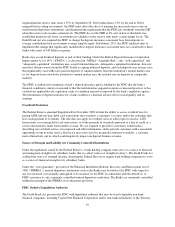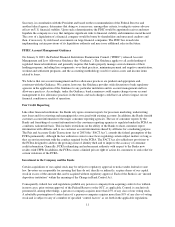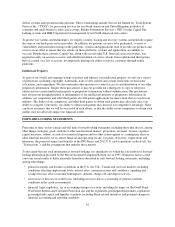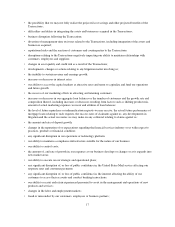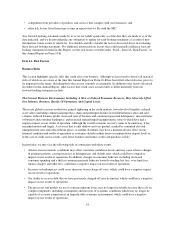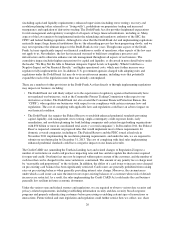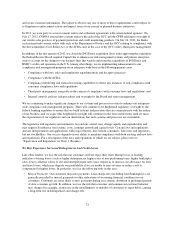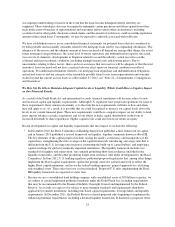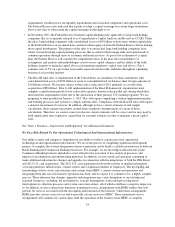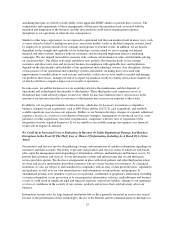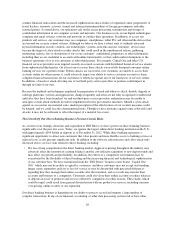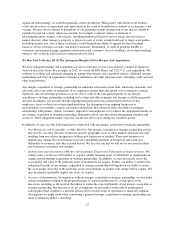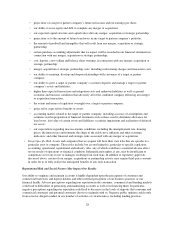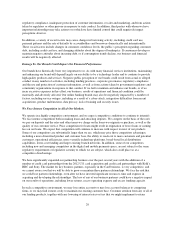Capital One 2012 Annual Report Download - page 38
Download and view the complete annual report
Please find page 38 of the 2012 Capital One annual report below. You can navigate through the pages in the report by either clicking on the pages listed below, or by using the keyword search tool below to find specific information within the annual report.• Our ability to assess the creditworthiness of our customers may be impaired if the criteria or models we use
to underwrite and manage our customers become less predictive of future losses, which could cause our
losses to rise and have a negative impact on our results of operations.
• Significant concern regarding the creditworthiness of some of the governments in Europe and uncertainty
stemming from U.S. debt and budget matters have contributed to volatility in the financial markets and led
to greater economic uncertainty worldwide. Concerns about sovereign debt in Europe and the U.S. debt
could diminish economic recovery and lead to further stress in the financial markets, both globally and in
the United States, which could have a negative impact on our financial results.
• Our ability to borrow from other financial institutions or to engage in funding transactions on favorable
terms or at all could be adversely affected by disruptions in the capital markets or other events, including
actions by rating agencies and deteriorating investor expectations, which could limit our access to funding.
The interest rates that we pay on our securities are also influenced by, among other things, applicable credit
ratings from recognized rating agencies. A downgrade to any of these credit ratings could affect our ability
to access the capital markets, increase our borrowing costs and have a negative impact on our results of
operations. Increased charge-offs, rising LIBOR and other events may cause our securitization transactions
to amortize earlier than scheduled, which could accelerate our need for additional funding from other
sources.
• We have increased our reliance on deposit funding over the past several years, in particular with the acquisition
of ING Direct, and an inability to accept or maintain deposits or to obtain other sources of funding could
materially affect our liquidity position and our ability to fund our business. Many other financial institutions
have also increased their reliance on deposit funding and, as such, we expect continued competition in the
deposit markets. We cannot predict how this competition will affect our costs. If we are required to offer
higher interest rates to attract or maintain deposits, our funding costs will be adversely impacted.
• Interest rates have remained at historically low levels for a prolonged period of time, and the flat yield curve
associated with current interest rates generally leads to lower revenue and reduced margins because it limits
our opportunity to increase the spread between asset yields and funding costs. The continued presence of a
flat yield curve for a sustained period of time could have a material adverse effect on our earnings and our
net interest margin.
• The historically low interest rate environment also increases our exposure to prepayment risk, particularly
with respect to the originated mortgage portfolio we acquired from ING Direct. Increased prepayments,
refinancing or other factors would reduce expected revenue associated with mortgage assets and could also
lead to a reduction in the value of our mortgage servicing rights, which could have a negative impact on our
financial results.
Compliance With New And Existing Laws, Regulations And Regulatory Expectations May Increase Our
Costs, Reduce Our Revenue, Limit Our Ability To Pursue Business Opportunities, And Increase Compliance
Challenges.
There has been increased legislation and regulation with respect to the financial services industry in the last few
years, and we expect that oversight of our business will continue to expand in scope and complexity. A wide and
increasing array of banking and consumer lending laws apply to almost every aspect of our business. Failure to
comply with these laws and regulations could result in financial, structural and operational penalties, including
receivership, and could result in negative publicity or damage to our reputation with regulators or the public. In
addition, establishing systems and processes to achieve compliance with these laws and regulations may increase
our costs and limit our ability to pursue certain business opportunities.
The Dodd-Frank Act, as well as the related rules and regulations adopted by various regulatory agencies, could
have a significant adverse impact on our business, results of operations or financial condition. The Dodd-Frank
Act is a comprehensive financial reform act that requires, among other things, enhanced prudential standards
19



